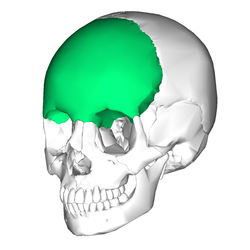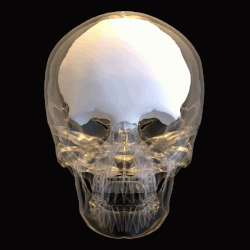Frontal bone
| Frontal bone | |
|---|---|
 Position of the frontal bone (highlighted in green). | |
 Animation of the frontal bone | |
| Details | |
| Articulations | Twelve bones: the sphenoid, the ethmoid, the two parietals, the two nasals, the two maxillae, the two lacrimals, and the two zygomatics |
| Identifiers | |
| Latin | os frontale |
| MeSH | D005624 |
| TA98 | A02.1.03.001 |
| TA2 | 520 |
| FMA | 52734 |
| Anatomical terms of bone | |
In the
Structure
The frontal bone is made up of two main parts. These are the
Borders
The border of the squamous part is thick, strongly serrated, bevelled at the expense of the inner table above, where it rests upon the parietal bones, and at the expense of the outer table on either side, where it receives the lateral pressure of those bones; this border is continued below into a triangular, rough surface, which articulates with the great wing of the sphenoid. The posterior borders of the orbital plates are thin and serrated, and articulate with the small wings of the sphenoid. [1]
Development
The frontal bone is presumed to be derived from
The frontal bone is
At birth the bone consists of two pieces, separated by the
Other animals
In most
Dinosaurs
The frontal bone is one of the principal paired mid-line bones in dinosaur skulls. This bone is part of the skull roof, which is a set of bones that cover the brain, eyes and nostrils. The frontal makes contact with several other bones in the skull. The anterior part of the bone articulates with the nasal bone and the prefrontal bone. The posterior part of the bone articulates with the postorbital bone and the parietal bone. This bone defines all of part of the upper margin of the orbit.
See also
References
![]() This article incorporates text in the public domain from page 135 of the 20th edition of Gray's Anatomy (1918)
This article incorporates text in the public domain from page 135 of the 20th edition of Gray's Anatomy (1918)
- ^ a b Gray's Anatomy (1918)
- ISBN 9780702068515.
- PMID 2197017.
- ISBN 0-03-910284-X.
External links
- Anatomy photo:23:os-0101 at the SUNY Downstate Medical Center
- "Anatomy diagram: 34256.000-1". Roche Lexicon - illustrated navigator. Elsevier. Archived from the original on 2012-12-27.
